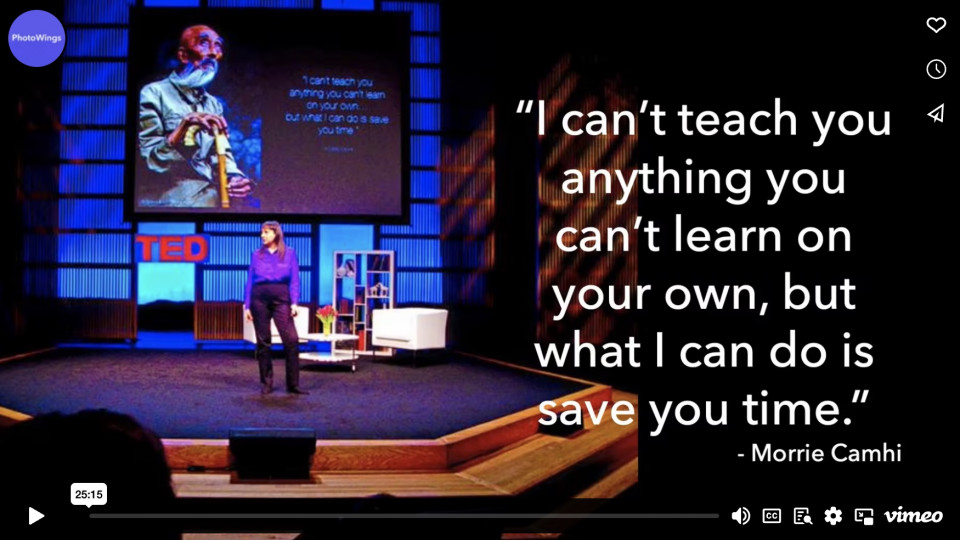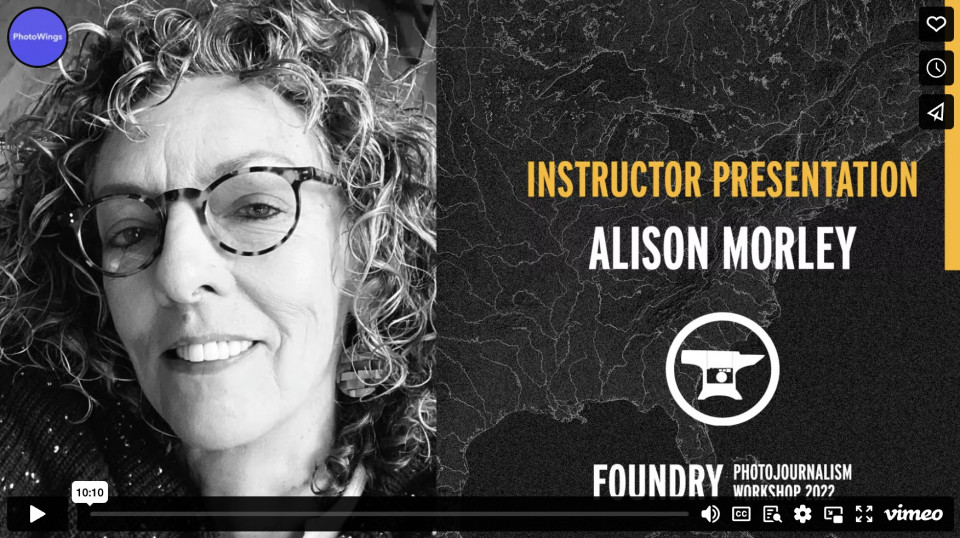PhotoWings Video Archive
Our long-term partner, PhotoWings, highlights and helps facilitates the power of photography to influence the world. Learn more about what they offer here.
Watch PhotoWings’ informative and inspirational interviews with Foundry faculty and other key photojournalists. Here’s the list.
Video Resources
Keynote: Nariman El-Mofty | Pulitzer Prize/Foundry Alum
Foundry 2023 – Suzie Katz | PhotoWings Presentation
Ron Haviv Ethics Presentation
Professional Guidelines
Visual journalists operate as trustees of the public. Our primary role is to report visually on the significant events and varied viewpoints in our common world. Our primary goal is the faithful and comprehensive depiction of the subject at hand. As visual journalists, we have the responsibility to document society and to preserve its history through images.
Photographic and video images can reveal great truths, expose wrongdoing and neglect, inspire hope and understanding and connect people around the globe through the language of visual understanding. Photographs can also cause great harm if they are callously intrusive or are manipulated.
This code is intended to promote the highest quality in all forms of visual journalism and to strengthen public confidence in the profession. It is also meant to serve as an educational tool both for those who practice and for those who appreciate photojournalism. To that end, The National Press Photographers Association sets forth the following.
-
- NPPA Code of Ethics
- Visual journalists and those who manage visual news productions are accountable for upholding the following standards in their daily work:
- Be accurate and comprehensive in the representation of subjects.
- Resist being manipulated by staged photo opportunities.
- Be complete and provide context when photographing or recording subjects. Avoid stereotyping individuals and groups. Recognize and work to avoid presenting one’s own biases in the work.
- Treat all subjects with respect and dignity. Give special consideration to vulnerable subjects and compassion to victims of crime or tragedy. Intrude on private moments of grief only when the public has an overriding and justifiable need to see.
- While photographing subjects do not intentionally contribute to, alter, or seek to alter or influence events.
- Editing should maintain the integrity of the photographic images’ content and context. Do not manipulate images or add or alter sound in any way that can mislead viewers or misrepresent subjects.
- Do not pay sources or subjects or reward them materially for information or participation.
- Do not accept gifts, favors, or compensation from those who might seek to influence coverage.
- Do not intentionally sabotage the efforts of other journalists.
- Ideally, visual journalists should:
- Strive to ensure that the public’s business is conducted in public. Defend the rights of access for all journalists.
- Think proactively, as a student of psychology, sociology, politics and art to develop a unique vision and presentation. Work with a voracious appetite for current events and contemporary visual media.
- Strive for total and unrestricted access to subjects, recommend alternatives to shallow or rushed opportunities, seek a diversity of viewpoints, and work to show unpopular or unnoticed points of view.
- Avoid political, civic and business involvements or other employment that compromise or give the appearance of compromising one’s own journalistic independence.
- Strive to be unobtrusive and humble in dealing with subjects.
- Respect the integrity of the photographic moment.
- Strive by example and influence to maintain the spirit and high standards expressed in this code. When confronted with situations in which the proper action is not clear, seek the counsel of those who exhibit the highest standards of the profession. Visual journalists should continuously study their craft and the ethics that guide it.
- NPPA Code of Ethics
Media Company and Contest Rules
-
- Associated Press Images
- AP pictures must always tell the truth. We do not alter or digitally manipulate the content of a photograph in any way.
- The content of a photograph must not be altered in Photoshop or by any other means. No element should be digitally added to or subtracted from any photograph. The faces or identities of individuals must not be obscured by Photoshop or any other editing tool. Only retouching or the use of the cloning tool to eliminate dust on camera sensors and scratches on scanned negatives or scanned prints are acceptable.
- Minor adjustments in Photoshop are acceptable. These include cropping, dodging and burning, conversion into grayscale, and normal toning and color adjustments that should be limited to those minimally necessary for clear and accurate reproduction (analogous to the burning and dodging previously used in darkroom processing of images) and that restore the authentic nature of the photograph. Changes in density, contrast, color and saturation levels that substantially alter the original scene are not acceptable. Backgrounds should not be digitally blurred or eliminated by burning down or by aggressive toning. The removal of “red eye” from photographs is not permissible.
- Except as described herein, we do not stage, pose or re-enact events. When we shoot video, environmental portraits, or photograph subjects in a studio care should be taken to avoid, misleading viewers to believe that the moment was spontaneously captured in the course of gathering the news. In the cases of portraits, fashion or home design illustrations, any intervention should be revealed in the caption and special instructions box so it can’t be mistaken as an attempt to deceive.
- Associated Press Images
-
- World Press Photo: Entrants to the World Press Photo contest must ensure their pictures provide an accurate and fair representation of the scene they witnessed so the audience is not misled. This means that entrants:
-
- Should be aware of the influence their presence can exert on a scene they photograph, and should resist being misled by staged photo opportunities.
- Must not intentionally contribute to, or alter, the scene they picture by re-enacting or staging events.
- Must maintain the integrity of the picture by ensuring there are no material changes to content.
- Must ensure captions are accurate.
- Must ensure the editing of a picture story provides an accurate and fair representation of its context.
- Must be open and transparent about the entire process through which their pictures are made, and be accountable to the World Press Photo Foundation for their practice.
-
- World Press Photo: Entrants to the World Press Photo contest must ensure their pictures provide an accurate and fair representation of the scene they witnessed so the audience is not misled. This means that entrants:
Books by Current and Past Instructors
Attention Service Member Ben Brody
Endgame Afghanistan Ben Brody
Infinity Goes Up on Trial Alan Chin
Creating Visual Narratives Through Photography Mike Davis
Il Bel Pais Stefano De Luigi
Afghanistan: The Road to Kabul Ron Haviv
Blood and Honey: A Balkan War Journal Ron Haviv
IMAGINARIUM: The Process Behind the Pictures Claire Rosen
We Cry in Silence Smita Sharma
Dancing on Fire Maggie Steber
Rite of Passage: Madje Has Dementia Maggie Steber
Recommended Reading List
courtesy of Alison Morley & Dr. Lauren Walsh
Associated Press Guide to Photojournalism, Brian Horton 2000
Photojournalism and Today’s News, Loup Langton 2008
Photojournalism: The Professionals’ Approach, Kenneth Kobre 2016
The Documentary Impulse, Stuart Franklin 2016
Magnum: Fifty Years at the Front Line of History, Russel Miller 1999
Questions without Answers, VII 2012
Moments: The Pulitzer Prize-winning Photographs, Hal Buell 2015
Bending the Frame, Fred Ritchin 2013
Frank, Robert. The Americans. [Grove Press, 1959]
Josef Koudelka. Exiles. New York: Aperture, c1988.
Dan Eldon, The Journey Is the Destination: The Journals of Dan Eldon, San Francisco: Chronicle Books, 1997.
Leonard Freed, Black in White America, New York: Grossman, 1967
Don McCullin, Is Anyone Taking Notice? Cambridge MA: MIT Press, c1971.
Gilles Peress, The Graves: Srebrenica and Vukovar, New York: Scalo, 1998.
Roger Ballen, Dorps-Small Towns of South Africa, Clifton Publications, 1986.
Bill Burke, I want to Take Picture, Atlanta GA: Nexus Press, c1987.
Bruce Davidson, East 100th, Cambridge MA; Harvard University Press, 1970.
Luc Delahaye. History, London: Chris Boot, c2000
Dan Eldon, The Journey Is the Destination: The Journals of Dan Eldon, San Francisco: Chronicle Books, 1997.
Horst Faas & Tim Page, Requiem, New York: Random House, 1997.
Stephen Ferry. I am Rich Potosi: The Mountain that Eats Men. New York: Monacelli Press, 1999.
Leonard Freed, Black in White America, New York: Grossman, 1967
Paul Fusco, Chernobyl Legacy, Millerton, NY: de.Mo., 2001.
Phillip Jones Griffiths, Vietnam, Inc. New York: MacMillan, 1971.
Here is New York: A Democracy of Images, Scalo, 2002.
Kenneth Jarecke, Just Another War, Text by Exene Cerevenka, Introduction by John Hockenbery, Joliet, Mont.: Bedrock Press, 1992.
Chris Killip, In Flagrante, With an essay by John Berger and Sylvia Grant, London: Secker and Warburg, 1988.
Josef Koudelka. Exiles. New York: Aperture, c1988.
Antonin Kratochvil, Broken Dream, New York: Monacelli Press,
Joachim Ladefoged, Albanians. Copenhagen: Arnold Busck 2000.
Danny Lyon, The Movement, New York: Simon & Schuster, 1964




